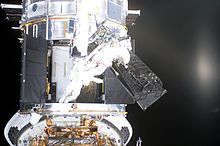
Back كاميرا استقصائية متقدمة Arabic Cámara avanzada para sondeos Spanish دوربین پیشرفته نقشهبرداری Persian Advanced Camera for Surveys French Advanced Camera for Surveys Hungarian 掃天観測用高性能カメラ Japanese 첨단관측카메라 Korean Advanced Camera for Surveys Portuguese กล้องสำรวจขั้นสูง Thai Gelişmiş Ölçme Kamerası Turkish



The Advanced Camera for Surveys (ACS) is a third-generation axial instrument aboard the Hubble Space Telescope (HST). The initial design and scientific capabilities of ACS were defined by a team based at Johns Hopkins University. ACS was assembled and tested extensively at Ball Aerospace & Technologies Corp. and the Goddard Space Flight Center and underwent a final flight-ready verification at the Kennedy Space Center before integration in the cargo bay of the Columbia orbiter. It was launched on March 1, 2002, as part of Servicing Mission 3B (STS-109) and installed in HST on March 7, replacing the Faint Object Camera (FOC), the last original instrument. ACS cost US$86 million at that time.[1]
ACS is a highly versatile instrument that became the primary imaging instrument aboard HST. It offered several important advantages over other HST instruments: three independent, high-resolution channels covering the ultraviolet to the near-infrared regions of the spectrum, a large detector area and quantum efficiency, resulting in an increase in HST's discovery efficiency by a factor of ten, a rich complement of filters, and coronagraphic, polarimetric, and grism capabilities. The observations undertaken with ACS provided astronomers with a view of the Universe with uniquely high sensitivity, as exemplified by the Hubble Ultra-Deep Field, and encompass a wide range of astronomical phenomena, from comets and planets in the Solar System to the most distant quasars known.
- ^ McKee, Maggie. "NASA attempts to revive Hubble's main camera". New Scientist.